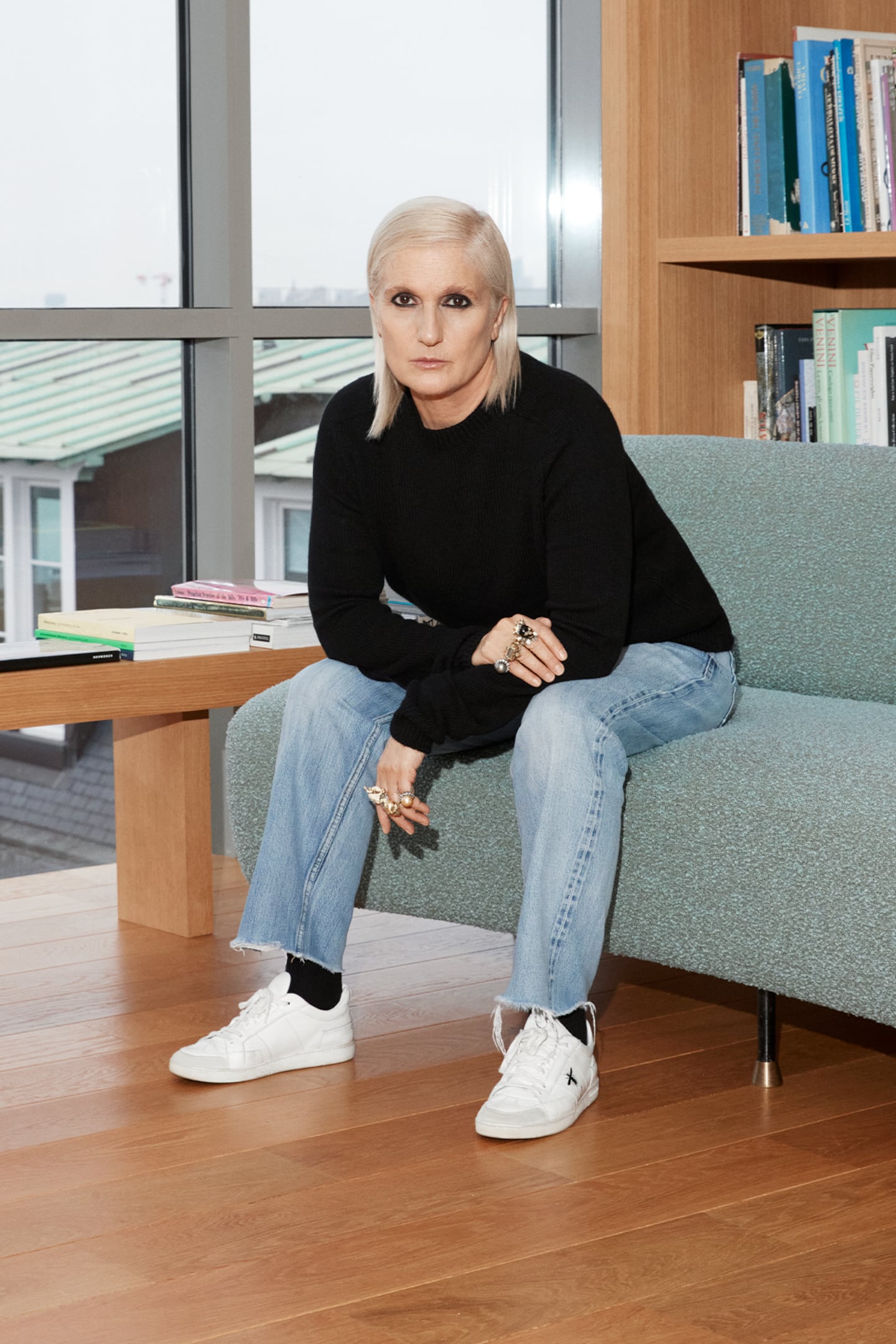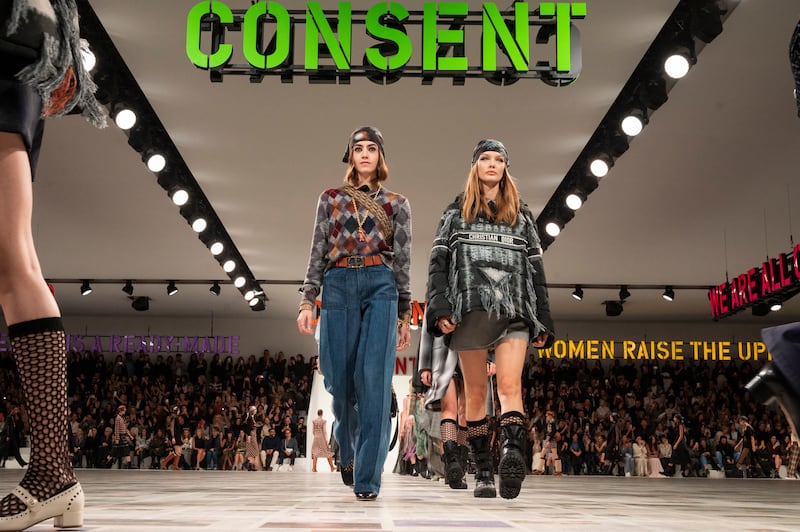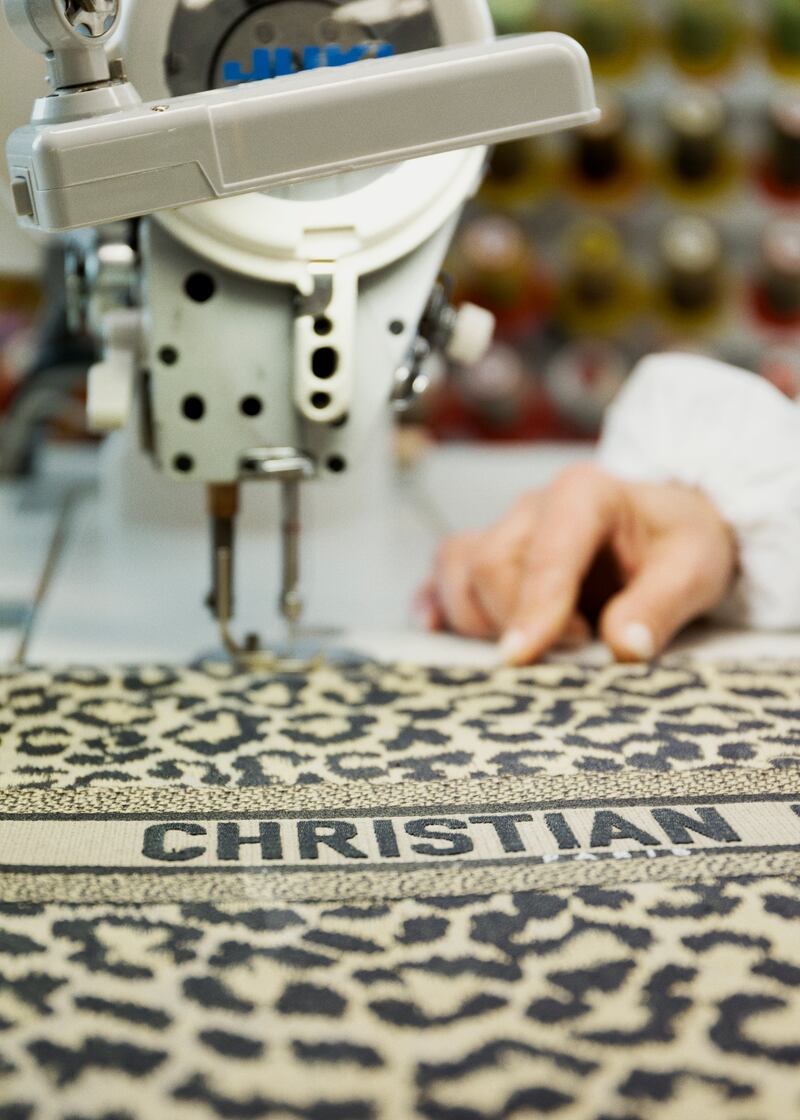
The Business of Fashion
Agenda-setting intelligence, analysis and advice for the global fashion community.

Agenda-setting intelligence, analysis and advice for the global fashion community.

PARIS – Dior’s haute couture show on Monday unfurled in front of a series of metres-long tapestries — 22 monumental pieces in all — designed by the Indian artists Madhvi and Manu Parekh. Creative director Maria Grazia Chiuri, the first woman to lead the brand in its 75-year history, had commissioned the works in order to highlight Dior’s partnership with Chanakya, a workshop and craftsmanship school for women in Mumbai that hand-embroidered the tapestries as well as helping to produce the collection.
The looks, too, were richly embroidered — with Chiuri opting for a mostly black-and-white palette that aimed to highlight the embroidery, not just as a decorative element but as a means of structuring a silhouette. Gowns appeared to be held together by thousands of dangling crystals, while slingback pumps were embroidered all over, including their heels. In spite of the layers of couture ornament, the collection projected an impression of lightness and easy movement, with the womanly gowns that are couture’s bread-and-butter mixed with sportier options, like effortless satin Bar suits and off-the-shoulder leotards (inspired by Fellini, the designer said).
0 of 64
The show was the latest expression of Chiuri’s vision for a more global, wearable Dior — powered by collaborations and feminist values. While some fashion insiders resisted the shift from theatrical silhouettes to a more broadly relatable aesthetic, Chiuri’s approach has cemented her position as one of the industry’s most bankable stars.
“Everyone in fashion is so nostalgic, everyone has an idea of Dior. For fashion, it’s like the national football team,” Chiuri told BoF. “I think you have to respect the heritage but at the same time you have to move the brand into the future. You have to have a dialogue with the women today.”
ADVERTISEMENT
Today’s women have certainly responded. In five years and 33 collections, Maria Grazia Chiuri has helped to transform one of France’s most famous couture houses into a commercial juggernaut. While owner LVMH does not report sales for individual brands, HSBC estimates that Dior’s revenues have more than tripled since Chiuri joined the company in 2016, rising to €6.2 billion in 2021 ($7 billion).
Including an estimated €3 billion in additional revenue from the brand’s perfume and beauty division, the Dior name has now likely surpassed both Hermès and Gucci to become the luxury fashion industry’s third-biggest brand, behind only Louis Vuitton and Chanel.
Chiuri’s influence hasn’t been limited to Dior, with signatures imitated far and wide including 2017′s logo-printed shoulder straps, the high-low silhouette of T-shirts tucked into tulle skirts or 2021′s tie-and-dye motifs. Her logo-embroidered Book tote, and her revised, elevated reedition of Dior’s Saddle bag (originally an early 2000s Galliano hit) have been among the hottest accessories in recent memory. Chiuri has even managed to bring back hats.
Leaned back on a sofa beneath the bright photo lights of Dior’s Paris design studio, Chiuri occasionally glanced up at the final fittings underway for her collection as she outlined the principles that have helped to make Christian Dior Couture relevant for a new generation of consumers.
Global Collaborations
Since her arrival at Dior, Chiuri’s move to spotlight traditions from Indonesia, Morocco and Mexico rather than to stay in her lane as a European designer has at times been critiqued as colonial. But she’s remained undeterred in her mission to enrich Dior’s storytelling and its craftsmanship through partnerships she defends as “cultural appreciation” — not appropriation.

Tuesday’s Indian collaboration followed partnerships with artists and artisans ranging from feminist artist Judy Chicago to Ivorian wax dyers and tombolo lace-makers in Puglia. “We have the responsibility to support craftsmanship around the world, where we find this expertise. It’s a dialogue where you learn and give back other knowledge,” Chiuri said.
The existing vision of an haute couture atelier, she explained, with its petites mains doing everything themselves in Paris, is both “nostalgic and not realistic about what it means today to have an atelier — it’s something global,” she said. “I really believe in being a community designer, not with this idea of a creative director in a torre de Pisa.”
ADVERTISEMENT
The partnerships with local artists and craftspeople have helped to reframe the brand’s extravagant spectacles, especially its destination cruise shows, in a more meaningful light. For its show in Greece last June, the brand incorporated silk from the Macedonian hinterlands, embroideries from a traditional workshop in the Peloponnese and illustrations from an artist on the far-flung island of Thasos to conjure an unprecedented synthesis between a major French haute couture house and a country whose artisanal heritage has been little known to the fashion world.
They’ve also helped Dior to find a novel point of view on fashion’s most perennial, relatable themes, be it Ancient Greece or astrology. Chiuri even found a fresh angle on equestrianism, for example, by looking at the costumes and performances of Mexico’s Escaramuza rodeo dancers. Chiuri’s team then travelled to the country to shoot the collection with Mexican women photographers, including the acclaimed Graciela Iturbide. The collection was a hit.
Paris fashion designers (including her predecessors Raf Simons and John Galliano) have long looked abroad for inspiration, but rarely have they shared the spotlight so openly with the communities that informed their research.
Feminine Meets Feminist
At a brand that had been defined for decades by a view of femininity held by male designers, Chiuri’s most talked-about changes to Dior have often been her efforts to make it a brand that’s not just feminine, but feminist as well.
She has included direct feminist messages in her collections, starting by emblazoning the title of Chimamanda Ngozi Adichie’s famous 2014 essay “We Should All Be Feminist” on a graphic T-shirt for her Spring/Summer 2017 debut. Coming from a brand owned by patriarch Bernard Arnault — Europe’s richest man — and at a time when fatigue with corporate “virtue signalling” and social media-ready slogans was becoming widespread, the move was met with scepticism as well as buzz. The T-shirt’s $850 price tag didn’t help.
But Chiuri persisted, going on to fly a billboard reading “CONSENT” over a runway show, and sending Natalie Portman to the Oscars red carpet with the names of historically snubbed female directors stitched into the hem of her cape.

The messages still don’t always land — as with a Met Gala ensemble for Cara Delevigne that read “Peg the Patriarchy.” But the consistency with which she has defended her values and put them into action by spotlighting women artists has helped her to win over previous doubters.
ADVERTISEMENT
“There’s always a tension between this message and the huge brand which is Dior and LVMH,” said the fashion historian Alexandre Samson. “But she truly believes in it.”
For early adopters of Chiuri’s vision, the straightforwardness of her message is part of its appeal. After all, who else ever tried to compress the complex oeuvre of references like Linda Nochlin or Niki de Saint Phalle into digestible messages that could be emblazoned on clothes, and marketed at the scale of a multi-billion dollar brand?
The messaging has been a sales driver, particularly among the millennial and Gen-Z clients who are driving growth for the luxury industry. “This is a demographic that wants to stand for something, who is really open about her point of view,” said Maria Milano, the longtime head buyer at Harrods and now chief merchant at e-tailer Olivela.
“Women are not stupid. When they go to the store they need to find [a product] that gives them an emotion they like, and that they desire,” Chiuri said. “At the same time in this moment it’s also important that you express values.”
Chiuri’s feminism is often present in her designs, beyond the slogans, as she works to update Dior’s classic silhouettes like the nipped-waist Bar jacket for women’s lifestyles today. At first glance, her designs often appear to express traditional notions of femininity, but upon closer inspection have been lightened, relaxed and adapted for a woman in motion.
“The idea is that you should be able to wear Dior in every moment of the day,” Chiuri said. “Women today, they go in the office, they take a train. They don’t have the same style of life as in the past. They want to take a walk — for me that’s important because it means to be free.”
Fusing Creativity and Commerce
Chiuri launched her career as an accessories designer at Fendi — working with accessories director Silvia Fendi during the Baguette’s heyday — before working at Valentino for 17 years alongside Pierpaolo Piccioli, where they helped to guide a period of rapid growth with their signature “rockstud” accessories.
At Dior, a brand that was long defined by the theatrical vision of English design auteur John Galliano, Chiuri overturned expectations for the creative director by maintaining a laser focus on developing wearable products.
Working alongside Dior’s former chief executive Sidney Toledano for 2 years, and then his successor Pietro Beccari, she overhauled the brand’s lineup of commercial items —introducing a lighter, more casual take on its founding Bar silhouette, and hit items like the embroidered Book tote. She speaks about her commercial successes like the Book tote with pride — and is known for approaching their design with the same care and attention to detail as she would a couture ensemble.“In my vision there is no show collection and then the commercial-commercial. There is only one collection,” she said. “What goes on the runway goes into the store and the window. It’s about coherence and authenticity.”

Chiuri has pushed to raise the quotient of artisanal detail in Dior’s mass-produced items, working with the brand’s suppliers to develop new techniques for layering embroidery on bags and straps, and even patenting the process for stitching intricate motifs directly onto products rather than having to cut down embroidered fabric. “I’m more of an industrial designer in some ways,” she said.
“I am an Italian designer,” she continued. “Italian fashion is famous for prêt-à-porter, for the way they translate the couture codes in an industrial product. To create something that is not wearable, in my point of view, has no sense.”
Editor’s Note: This story has been updated on 25 January 2022. A previous version of this story mistakenly identified an acclaimed photographer as Maria Iturbide. That is incorrect. Her name is Graciela Iturbide. A previous version also misstated the number of Maria Grazia Chiuri’s shows for Dior. The haute couture show described in the story was the designer’s 33rd, not her 31st.
Disclosure: LVMH is part of a group of investors who, together, hold a minority interest in The Business of Fashion. All investors have signed shareholder’s documentation guaranteeing BoF’s complete editorial independence.
Disclosure: LVMH is part of a group of investors who, together, hold a minority interest in The Business of Fashion. All investors have signed shareholder’s documentation guaranteeing BoF’s complete editorial independence.
Today, as Dior stages a destination runway show in Italy, a new report shows the LVMH-owned brand's finances inching closer to those of its oldest rival, fashion-and-beauty juggernaut Chanel.
With a miniature collection, the house of Christian Dior literally scales back its presence at Paris Haute Couture Week. But don’t be fooled: Pietro Beccari speaks exclusively to BoF on how the brand is keeping its foot on the accelerator after a steep jump in sales last year.
The French fashion house will reveal its collection for the Cruise 2022 season in the Greek capital June 17, as owner LVMH continues to invest in

Robert Williams is Luxury Editor at the Business of Fashion. He is based in Paris and drives BoF’s coverage of the dynamic luxury fashion sector.
The Coach owner’s results will provide another opportunity to stick up for its acquisition of rival Capri. And the Met Gala will do its best to ignore the TikTok ban and labour strife at Conde Nast.
The former CFDA president sat down with BoF founder and editor-in-chief Imran Amed to discuss his remarkable life and career and how big business has changed the fashion industry.
Luxury brands need a broader pricing architecture that delivers meaningful value for all customers, writes Imran Amed.
Brands from Valentino to Prada and start-ups like Pulco Studios are vying to cash in on the racket sport’s aspirational aesthetic and affluent fanbase.